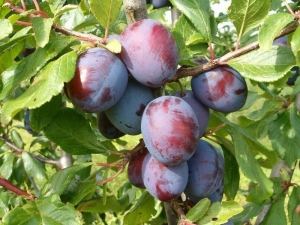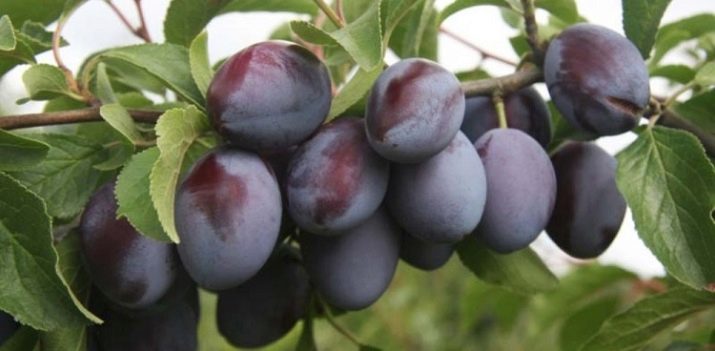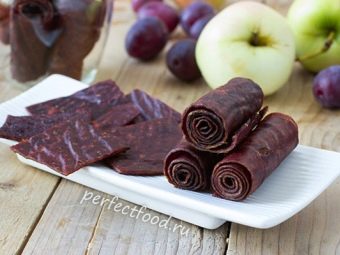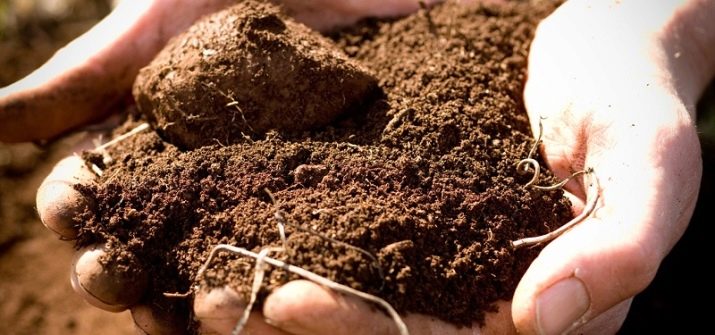Plum "President": characteristics of the variety and tips on growing

Plum "President" is considered a variety with a late fruit ripening.Practically all experienced gardeners prefer this particular variety, since it is high-yielding, and the plums themselves have excellent taste. It is also worth noting that the dignity of the variety is resistance to dry weather and frost.
Special features
The plum variety “President” has been popular with gardeners for over a century. This variety was bred by breeders from England in the early twentieth century. Since the plum is unpretentious to care and at the same time gives a lot of harvest, it quickly became popular outside of England.
Characteristics of the "President":
- the tree is considered tall (height can reach 4 meters);
- seedlings adapt perfectly to a new place and develop rapidly, for a year a tree can grow by 35 cm;
- the trunk of this variety has a smooth gray-green bark;
- peduncles of small size and thickness, due to which they are easily separated from the branches.
Every year in early spring the tree produces many shoots. If a gardener seeks high yields of large fruits with excellent taste, both old and new shoots must be removed.
Flowering plum of this variety begins in mid-May. Inflorescences are formed in the form of umbrellas with 3 large white flowers. During flowering plum emits a pleasant smell that spreads outside the site.
Fruits the tree with large berries. If the tree is young, then one fruit can weigh up to 100 grams; in adult trees, berries can be about 50 grams. The peel of the fruit is dense, has a purple color. The flesh is juicy and homogeneous.
The fruit contains 9% sugar, 14% solids, 3% acids, and about 4 milligrams of ascorbic acid. The fruit has a stone, pointed from 2 sides. It is quite easily separated from the pulp. According to the evaluation of taste tasters, the plum “President” received 4 points out of 5. The appearance of the fruits was also rated at 4 points.
This variety is considered to be self-fertile. Therefore, if the tree on the site is the only one, it will still bear fruit. If you want to get more harvest, then along with seedlings of this variety you should plant additional trees of a different type, which will act as pollinators.
Yield
The gardener gets the first harvest of the plum “President” after passing 5 years from the moment of planting the seedling. If the summer is warm, then the fruits ripen by early September. If the summer is cold, the harvest is postponed to the end of September. In addition, if autumn is cold and rainy, the taste and quality of the fruit deteriorate.
Description of the variety suggests that this type of plum is high-yielding. If the tree is young (about 7 years), then about 20 pounds of plums can be collected from it. If a tree is 10 years old, then 40 kg of fruits are collected from it. The maximum weight of fruits that can be collected from one tree reaches 60 kg.
Harvested berries are well kept. If the crop is harvested 7 days before absolute ripeness, then they can be stored in the refrigerator for a long time. In this case, the fruits will not lose their taste.
However, plucking immature plums is not recommended, as the fruit may remain hard and sour. Crop is used to make compotes, wine, jam and marshmallow.
Benefits
This cultivar of plum is very popular with gardeners. Such popularity is caused by the numerous advantages of the "President":
- early fruiting (fruits appear on the 5th year of the tree's life);
- resistance to frost (wood perfectly tolerates temperatures up to -30 degrees);
- rich and stable harvest;
- resistance to drought;
- excellent preservation of fruits and the possibility of their transportation;
- resistance to various biological aggressions.
The disadvantages of gardeners include a high level of thickening of the branches. To avoid this, it is necessary to regularly thin out the crown.
If there is a lot of harvest, it is necessary to install supports under the branches Reviews gardeners say that home plum presented varieties unpretentious.Its frost resistance is impressive, and the landing does not cause much trouble.
How to grow?
If you want your every tree to grow healthy and strong, it is necessary to take into account the characteristics of the variety at all stages.
- The choice of location. It is necessary to choose a spacious area for plum planting, so that the tree can freely scatter branches. Also the place should be well ventilated. This will partially protect the plant from various diseases.
- Timing. The ideal time for plum planting is the beginning of spring or autumn. This is explained by the fact that at this time of the cold still (or already) do not have time to influence the young sapling, and it is actively growing and developing. As practice shows, a tree planted in the autumn period bears fruit for 6 years after planting. The optimum temperature during planting should not be below +15 degrees.
- Priming. Although the condition of the soil is not finicky plum, it is proved that the tree gives more yield if it grows in loamy, airborne ground. Also, the plum grows well and develops in areas where there is groundwater at a distance of 2 meters deep. If the tree is planted in strongly acidified soil, then it must be pre-treated and fed with lime.
- Liming. This procedure is desirable to perform in early spring, while the site has not yet been dug. For top dressing of the soil you can use dolomite flour, slate ash and chalk. You must use 0.5 kg of the mixture per 1 m2. After the site is sprinkled with the mixture, you can begin to dig it. Such a procedure brings many benefits. It normalizes the structure of the soil, increases the indicators of the air and water permeability of the earth, provides the soil with magnesium, calcium and other useful qualities.
Wood ash can also be used to reduce soil acidity. In this case, be aware that for 10 square meters, you will need 2 buckets of ash.
Selection of seedlings
Acquire seedlings plum "President" is recommended in the fall. During this period, damage to the root system or the bark of a young tree is clearly seen. It is better to buy such trees in a nursery located near the site of the intended landing. This is explained by the fact that seedlings are already adapted to the region and climate in which they are sold, which means that they will better take root in a permanent place.
If the seedling is good, it will have a root system with 5 skeletal branches. After purchasing the tree, it is necessary to transfer the house, and in order not to damage the root during transportation, it is better to roll it up with a damp cloth. To seedlings survive the winter, they are better prikopat ground layer of 40 cm. It is important not to forget to put a couple of sprigs of coniferous trees, they will scare off rodents.
Landing technology
Of great importance is the preparation of seedlings. At this stage, the plant with dry roots should be placed in a container with water for 2 days. After that, the roots are dipped in a clay mash.
The landing hole must be properly prepared. The fossa is dug a few weeks before planting. At the bottom of the dug hole spread fertilizer and fertilizer. After that, a stake is driven in, which will act as a support. In order to conveniently place fertilizers on the bottom, the hole needs to be made about 60 cm deep and 80 cm wide.
In order for the plum to settle down perfectly in the new place, the ground that was removed from the excavated hole must be divided and some part mixed in a bucket of humus and superphosphate. Then this mixture is poured to the bottom of the fossa, and a tree is planted in it. In this case, the root neck of the plant should be on the surface. After the seedling has been planted, it will be necessary to pour 30 liters of warm distilled water under it and cover with a layer of dry grass or sawdust.
Optimally take root seedlings at the age of not more than one year. When planting, it is recommended to remove from the sapling 2 lower buds. If several trees are planted, a distance of at least 3 meters should be left between them.So trees become less susceptible to the appearance of fungi of various types, while pollinators feel more comfortable.
Care
As mentioned above, the “President” is unpretentious. He is not afraid of drought and insufficient soil moisture, does not require special care. But still, if you follow the recommendations of experts, you can get a lot more quality fruits.
- Watering. It is advisable to carry out drip irrigation 1 time in 2 weeks. The amount of water per tree is at least 40 liters in the first half of summer and at least 20 liters in the second half of the same period.
- Top dressing. If to carry out periodic top dressing, then productivity considerably increases. If the tree is young, then it is enough to pour 20 grams of urea and saltpeter. If the tree is more than 5 years old, then it is better to add one 10-liter compost bucket, 15 grams of potassium chloride, 50 grams of superphosphate and 20 grams of urea (per 1 m2 plot in spring). In the autumn, after the harvest, it is desirable to mix 40 grams of wood ash, 30 grams of potassium salt and 60 grams of superphosphate and bring the mixture under the tree.
- Crop. In the first 3 years of life, the plum needs timely pruning. Such work is recommended to be carried out in early spring, until sap flow is started on the tree. If the plant has grown new shoots, it is desirable to shorten them by 10 cm, leaving only 3 skeletal twigs. If the tree is more than 5 years old, then it needs rejuvenating pruning. This means that it is necessary to remove the lower new shoots and old damaged ones.
In the next video you will find instructions for pruning fruit trees on the example of plum varieties "President."































